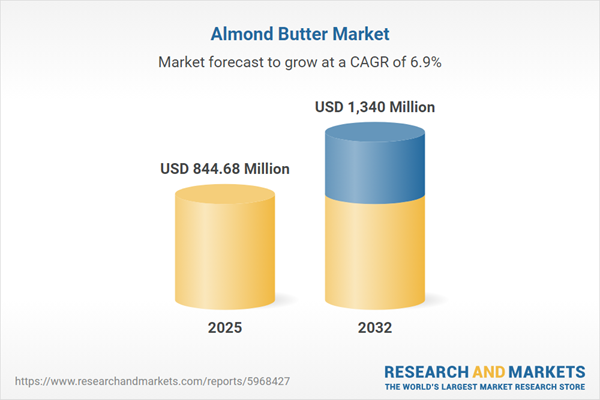Speak directly to the analyst to clarify any post sales queries you may have.
The almond butter market is experiencing significant transformation, propelled by shifts in consumer behavior, evolving dietary preferences, and the rising demand for plant-based, nutrient-rich spreads. Industry stakeholders seeking to capture new growth must navigate complex drivers shaping innovation, supply chains, and global consumption trends.
Market Snapshot: Almond Butter Market Size and Growth
The almond butter market grew from USD 791.21 million in 2024 to USD 844.68 million in 2025 and is projected to reach USD 1.34 billion by 2032 at a CAGR of 6.87%. This robust growth underscores broadening appeal, expanding product portfolios, and heightened investments in supply chain resilience and technological advancements. The primary keyword, almond butter market, is central to assessing strategic opportunities in this evolving category for senior B2B decision-makers.
Scope & Segmentation
This comprehensive report provides critical insights into the competitive landscape and segmentation drivers of the almond butter industry.
- End Use: Foodservice applications; Retail consumption scenarios
- Packaging Types: Jars (glass and plastic); Single-serve packets for convenience and portability
- Source Profiles: Raw almond butters favoring authentic flavor; Roasted varieties offering richer, smoother options
- Certification Standards: Conventional; Non-GMO; Organic, each meeting distinct consumer values and compliance demands
- Flavor Varieties: Chocolate; Classic; Honey; Vanilla, plus savory profiles catering to a broad range of palates
- Price Tiers: Economy; Premium; Standard, addressing diverse value perceptions and spending levels
- Product Types: Creamy; Crunchy; Mixed Nut for customizable textural preferences
- Distribution Channels: Natural food stores; Online retail (brand direct and marketplace); Specialty stores; Supermarkets (grocery chain and mass retail)
- Geographical Coverage: Americas (including North America and Latin America); Europe, Middle East, and Africa; Asia-Pacific
- Company Analysis: Includes leading industry players such as The J.M. Smucker Company, Hormel Foods Corporation, SunOpta Inc., The Hain Celestial Group, Blue Diamond Growers, Artisana Organics, Once Again Nut Butter, Wild Friends Foods, NuttZo, and Pip & Nut.
Key Takeaways
- Almond butter is increasingly positioned as a functional ingredient, aligning with wellness-focused and specialized dietary needs such as paleo, vegan, and low-carb.
- Premiumization, via small-batch production, gourmet packaging, and innovative flavors, is driving differentiation while commanding higher price points from quality-conscious consumers.
- Brands are investing in technology partnerships for advanced roasting and milling, ensuring product uniformity and operational efficiency.
- Sustainability initiatives, including transparent sourcing and responsible packaging, are fundamental to brand trust among eco-aware consumers.
- Digital and social media are accelerating product discovery, shaping purchasing trends, and enhancing D2C capabilities for faster feedback and iteration.
- Strategic regional tailoring is essential, as cultural preferences, economic contexts, and regulatory frameworks vary widely across key markets.
Tariff Impact
Revised tariffs enacted in 2025 have influenced sourcing and pricing across the almond butter industry. Manufacturers are adapting through altered procurement, closer grower collaborations, and optimized supply chain logistics. Enhanced analytics, duty optimization strategies, and hedging contracts are helping mitigate cost volatility and secure continuity in an increasingly complex international trade environment.
Methodology & Data Sources
This report is built upon rigorous secondary research from leading industry publications, complemented by direct interviews with executives and specialists. Data reliability is assured through triangulation, competitive benchmarking, and peer review, providing actionable insights into the evolving almond butter market.
Why This Report Matters
- Equips decision-makers with a granular view of key drivers, technological trends, and competitive moves shaping the market.
- Enables the identification of emerging growth opportunities, strategic risks, and regional demand dynamics.
- Supports evidence-based planning for product innovation, sourcing sustainability, and distribution channel optimization.
Conclusion
The almond butter market offers dynamic growth opportunities driven by evolving consumer preferences, technology, and sustainable sourcing imperatives. This report provides the intelligence needed for strategic decision-making and future-focused expansion.
Additional Product Information:
- Purchase of this report includes 1 year online access with quarterly updates.
- This report can be updated on request. Please contact our Customer Experience team using the Ask a Question widget on our website.
Table of Contents
3. Executive Summary
4. Market Overview
7. Cumulative Impact of Artificial Intelligence 2025
Companies Mentioned
The companies profiled in this Almond Butter market report include:- The J.M. Smucker Company
- Hormel Foods Corporation
- SunOpta Inc.
- The Hain Celestial Group, Inc.
- Blue Diamond Growers, Inc.
- Artisana Organics, LLC
- Once Again Nut Butter, Inc.
- Wild Friends Foods, LLC
- NuttZo, LLC
- Pip & Nut Ltd.
Table Information
| Report Attribute | Details |
|---|---|
| No. of Pages | 183 |
| Published | October 2025 |
| Forecast Period | 2025 - 2032 |
| Estimated Market Value ( USD | $ 844.68 Million |
| Forecasted Market Value ( USD | $ 1340 Million |
| Compound Annual Growth Rate | 6.8% |
| Regions Covered | Global |
| No. of Companies Mentioned | 11 |









